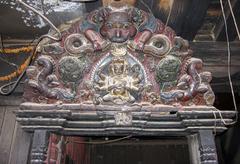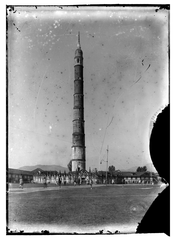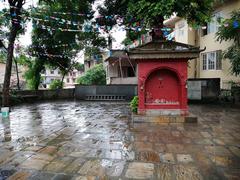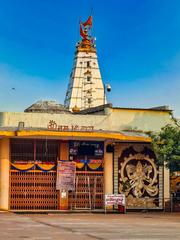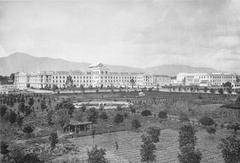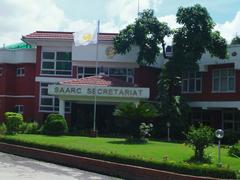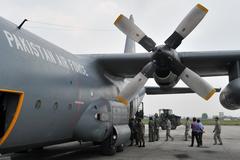Comprehensive Guide to Visiting Dhap Dam, Kathmandu, Nepal
Date: 23/07/2024
Introduction
Dhap Dam, situated in the scenic northeastern part of the Kathmandu Valley, Nepal, is a marvel of modern engineering and a significant historical site. This guide aims to explore the multifaceted aspects of Dhap Dam, covering its history, hydrological importance, agricultural benefits, environmental impact, socio-economic significance, and tourism potential. Whether you are a history enthusiast, nature lover, or a curious traveler, Dhap Dam offers a unique blend of natural beauty and cultural richness.
The construction of Dhap Dam began in 2010 as part of a broader initiative by the Government of Nepal to address the growing water scarcity in the Kathmandu Valley. The project received substantial funding and technical assistance from international organizations like the Asian Development Bank and the World Bank. Completed in 2018, Dhap Dam now stands as a testament to Nepal’s commitment to sustainable water resource management. With a storage capacity of 10 million cubic meters, the dam has significantly alleviated water shortages, supported agricultural activities, and provided a reliable water source for domestic and industrial use.
Beyond its functional benefits, Dhap Dam has emerged as a popular tourist destination, offering activities like boating, fishing, hiking, and bird watching. The surrounding area is rich in natural beauty and cultural heritage, making it an ideal location for a day trip or a longer stay. This guide provides essential visitor information, including visiting hours, ticket prices, travel tips, and nearby attractions, to help you make the most of your visit to Dhap Dam.
Table of Contents
- [Introduction](#introductionintroduction)
- [Early Conception and Planning](#early-conception-and-planningearly-conception-and-planning)
- [Feasibility Studies and Initial Proposals](#feasibility-studies-and-initial-proposalsfeasibility-studies-and-initial-proposals)
- [Government Approval and Funding](#government-approval-and-fundinggovernment-approval-and-funding)
- [Construction Phase](#construction-phaseconstruction-phase)
- [Environmental and Social Impact](#environmental-and-social-impactenvironmental-and-social-impact)
- [Completion and Inauguration](#completion-and-inaugurationcompletion-and-inauguration)
- [Post-Completion Developments](#post-completion-developmentspost-completion-developments)
- [Visitor Information](#visitor-informationvisitor-information)
- [Future Prospects](#future-prospectsfuture-prospects)
- [Scenic Beauty and Photography](#scenic-beauty-and-photographyscenic-beauty-and-photography)
- [Boating and Water Activities](#boating-and-water-activitiesboating-and-water-activities)
- [Hiking and Nature Walks](#hiking-and-nature-walkshiking-and-nature-walks)
- [Picnicking](#picnickingpicnicking)
- [Bird Watching](#bird-watchingbird-watching)
- [Fishing](#fishingfishing)
- [Camping](#campingcamping)
- [Local Cuisine and Refreshments](#local-cuisine-and-refreshmentslocal-cuisine-and-refreshments)
- [Cultural Insights](#cultural-insightscultural-insights)
- [Practical Tips for Visitors](#practical-tips-for-visitorspractical-tips-for-visitors)
- [Nearby Attractions](#nearby-attractionsnearby-attractions)
- [Special Events and Guided Tours](#special-events-and-guided-toursspecial-events-and-guided-tours)
- [Photographic Spots](#photographic-spotsphotographic-spots)
- [FAQ](#faqfaq)
- [Conclusion](#conclusionconclusion)
Early Conception and Planning
The idea of constructing Dhap Dam emerged as part of a broader initiative to address the growing water scarcity in the Kathmandu Valley. With its rapidly increasing population and urbanization, the valley faced significant challenges in ensuring a consistent and reliable water supply. The concept of Dhap Dam emerged from the need to create a sustainable water resource that could support both the local population and agricultural activities.
Feasibility Studies and Initial Proposals
Initial feasibility studies for Dhap Dam were conducted in the early 2000s. These studies aimed to assess potential sites, environmental impact, and technical requirements for the dam. The findings indicated that the Dhap area, located in the northeastern part of the Kathmandu Valley, was a suitable location due to its topography and proximity to water sources. The proposal for Dhap Dam was formally presented to the government in 2005, highlighting the benefits of improved water supply and flood control.
Government Approval and Funding
In 2008, the Government of Nepal approved the construction of Dhap Dam as part of its national water resource management strategy. The project received funding from both national and international sources, including the Asian Development Bank and the World Bank. The total estimated cost of the project was approximately USD 50 million. The funding was allocated for various phases of the project, including land acquisition, construction, and environmental mitigation measures.
Construction Phase
The construction of Dhap Dam began in 2010, with the primary contractor being a joint venture between local and international engineering firms. The dam was designed as an earth-fill embankment with a height of 45 meters and a length of 300 meters. The reservoir created by the dam has a storage capacity of 10 million cubic meters, providing a significant boost to the water supply in the Kathmandu Valley.
During the construction phase, several challenges were encountered, including difficult terrain, weather conditions, and logistical issues. Despite these challenges, the project progressed steadily, with significant milestones achieved by 2015. The construction phase also included the development of associated infrastructure, such as access roads, spillways, and water treatment facilities.
Environmental and Social Impact
The construction of Dhap Dam had both positive and negative impacts on the local environment and communities. On the positive side, the dam provided a reliable water source, reducing the dependency on groundwater and mitigating the effects of droughts. Additionally, the reservoir created new opportunities for recreational activities and tourism, contributing to the local economy.
However, the project also faced criticism for its environmental impact, particularly on the local ecosystem and wildlife. To address these concerns, the project included comprehensive environmental mitigation measures, such as reforestation, wildlife corridors, and water quality monitoring. The government also implemented social programs to support the affected communities, including compensation for displaced families and livelihood restoration initiatives.
Completion and Inauguration
Dhap Dam was completed in 2018, marking a significant milestone in Nepal’s water resource management efforts. The inauguration ceremony was attended by high-ranking government officials, representatives from funding agencies, and local community leaders. The dam was hailed as a critical infrastructure project that would enhance water security and support sustainable development in the Kathmandu Valley.
Post-Completion Developments
Since its completion, Dhap Dam has played a crucial role in addressing the water needs of the Kathmandu Valley. The reservoir has provided a reliable source of water for domestic, agricultural, and industrial use. Additionally, the dam has helped in flood control, reducing the risk of downstream flooding during the monsoon season.
The success of Dhap Dam has also inspired similar projects in other parts of Nepal, with the government prioritizing the development of water infrastructure to support the country’s growing population and economic activities. The lessons learned from the Dhap Dam project have been valuable in improving the planning, design, and implementation of future water resource projects.
Visitor Information
If you’re planning to visit Dhap Dam, here are some essential details to help you make the most of your trip:
- Visiting Hours: Dhap Dam is open to visitors from 8 AM to 6 PM daily.
- Ticket Prices: Entry to Dhap Dam is free of charge, but guided tours may have a nominal fee.
- Travel Tips: The best time to visit is during the dry season, from October to April, when the weather is pleasant. Wear comfortable shoes as the terrain can be uneven.
- Nearby Attractions: While in the area, consider visiting nearby attractions such as the historic Pashupatinath Temple and the bustling Thamel district.
- Accessibility: Dhap Dam is accessible by road, and parking is available on-site. Public transportation options are also available from major points in Kathmandu.
Future Prospects
Looking ahead, the Dhap Dam project continues to be a model for sustainable water resource management in Nepal. The government is exploring opportunities to enhance the dam’s capacity and efficiency through technological upgrades and improved management practices. Additionally, there are plans to develop the surrounding area as a tourist destination, leveraging the scenic beauty of the reservoir and its potential for recreational activities.
Scenic Beauty and Photography
Dhap Dam provides breathtaking views of the surrounding landscapes, making it a haven for nature photographers. The tranquil waters of the dam reflect the sky and the surrounding flora, creating picturesque scenes that are ideal for both amateur and professional photographers. Early morning and late afternoon are the best times to capture the stunning play of light and shadow on the water.
Boating and Water Activities
One of the main attractions at Dhap Dam is boating. Visitors can rent paddle boats or rowboats to explore the calm waters of the dam. Boating provides a unique perspective of the area, allowing tourists to enjoy the serene environment from the middle of the water. For those seeking a bit more adventure, kayaking is also available. The dam’s calm waters make it an excellent spot for beginners to try their hand at kayaking.
Hiking and Nature Walks
The area around Dhap Dam is crisscrossed with numerous trails that are perfect for hiking and nature walks. These trails vary in difficulty, catering to both casual walkers and serious hikers. One popular trail leads to a vantage point that offers a panoramic view of the dam and the surrounding valley. Along the way, hikers can enjoy the diverse flora and fauna of the region, including various species of birds and butterflies. Guided nature walks are also available for those interested in learning more about the local ecosystem.
Picnicking
Dhap Dam is a popular spot for picnics, especially among local families. The area around the dam is equipped with picnic tables and benches, making it a convenient place to enjoy a meal outdoors. Visitors can bring their own food or purchase snacks from vendors near the dam. The peaceful environment and scenic views make it an ideal location for a relaxing day out with family and friends.
Bird Watching
The diverse habitat around Dhap Dam attracts a wide variety of bird species, making it a haven for bird watchers. Early mornings and late afternoons are the best times for bird watching, as many species are most active during these times. Visitors can spot both resident and migratory birds, including kingfishers, herons, and various species of ducks. Bringing a pair of binoculars and a bird guidebook can enhance the bird-watching experience.
Fishing
Fishing is another popular activity at Dhap Dam. The dam is home to several species of fish, including carp and catfish. Visitors can rent fishing gear from local vendors or bring their own. Fishing permits are required and can be obtained from the local authorities. The calm and quiet environment makes fishing at Dhap Dam a relaxing and enjoyable experience.
Camping
For those looking to extend their stay, camping is an excellent option. There are designated camping areas around Dhap Dam where visitors can set up tents. Camping allows tourists to fully immerse themselves in the natural beauty of the area and enjoy activities like stargazing and campfire cooking. It is advisable to bring all necessary camping gear and supplies, as facilities may be limited.
Local Cuisine and Refreshments
Near Dhap Dam, there are several small eateries and food stalls where visitors can sample local Nepali cuisine. Popular dishes include momos (dumplings), dal bhat (lentil soup with rice), and sel roti (a traditional rice-based doughnut). These eateries provide a taste of local flavors and are a great way to experience the culinary culture of the region. Additionally, visitors can find refreshments like tea, coffee, and cold drinks to enjoy during their visit.
Cultural Insights
Dhap Dam is not just a natural attraction but also a place where visitors can gain insights into the local culture. The nearby villages often host cultural events and festivals that tourists can participate in. These events provide a glimpse into the traditional music, dance, and customs of the local communities. Engaging with the locals and learning about their way of life adds a rich cultural dimension to the visit.
Practical Tips for Visitors
- Best Time to Visit: The best time to visit Dhap Dam is during the spring (March to May) and autumn (September to November) when the weather is pleasant and the natural beauty is at its peak.
- What to Bring: It is advisable to bring comfortable walking shoes, a hat, sunscreen, and insect repellent. For those planning to stay longer, packing a picnic, water, and snacks is recommended.
- Safety: While the area is generally safe, it is important to follow local guidelines and respect the natural environment. Visitors should avoid littering and be mindful of wildlife.
Nearby Attractions
Visitors to Dhap Dam may also be interested in exploring other nearby attractions such as the historical sites in Kathmandu, including the famous Swayambhunath Stupa (Monkey Temple) and the ancient Durbar Square.
Special Events and Guided Tours
Throughout the year, Dhap Dam hosts special events and festivals that offer unique experiences. Guided tours are also available for those who wish to learn more about the area’s history, flora, and fauna.
Photographic Spots
For photographers, some of the best spots to capture the beauty of Dhap Dam include the vantage point on the hiking trail, the middle of the dam’s waters while boating, and the designated bird-watching areas.
FAQ
- What are Dhap Dam’s visiting hours? Dhap Dam is open daily from 8 AM to 6 PM.
- How much is the entry fee for Dhap Dam? Entry to Dhap Dam is free of charge, but some activities like boating and fishing may require a fee.
- What nearby attractions can I visit? Nearby attractions include the historic Pashupatinath Temple, the bustling Thamel district, Bhaktapur, Chisapani Hiking Trail, and Nagarkot viewpoint.
- What should I bring when visiting Dhap Dam? Comfortable walking shoes, a camera, and essentials for a day trip.
- Is Dhap Dam suitable for children? Yes, Dhap Dam is a family-friendly destination with activities suitable for all ages.
- Are pets allowed at Dhap Dam? Pets are generally allowed, but it is advisable to check local regulations and ensure pets are kept on a leash.
- Can I swim in Dhap Dam? Swimming is not recommended due to safety concerns and the preservation of the natural environment.
Conclusion
Dhap Dam is more than just a crucial water resource; it is a symbol of Nepal’s resilience and commitment to sustainable development. Completed in 2018, the dam has not only addressed the water scarcity issues in the Kathmandu Valley but has also transformed the local agricultural landscape, supported community development, and boosted tourism. The dam’s construction, supported by international organizations like the Asian Development Bank, has provided a reliable water source, enabled multiple crop cycles, and reduced poverty in the region. Despite facing challenges like environmental impact and the need for regular maintenance, Dhap Dam stands as a model for future water resource projects in Nepal. The surrounding natural beauty, combined with various recreational activities, makes it a must-visit destination for both locals and tourists. As efforts continue to enhance its capacity and sustainability, Dhap Dam will undoubtedly remain a vital asset for the Kathmandu Valley and beyond. Whether you are interested in its historical significance, hydrological importance, or simply looking for a serene getaway, Dhap Dam offers a unique and enriching experience. Don’t forget to download the Audiala mobile app for more travel tips and updates, and explore other related posts for further inspiration.
References
- ‘Exploring the History and Significance of Dhap Dam in Kathmandu’, 2023, Asian Development Bank
- ‘Explore Dhap Dam - History, Significance, Visitor Information & More’, 2023, Asian Development Bank
- ‘Complete Guide to Visiting Dhap Dam, Kathmandu - Attractions, Activities, and Tips’, 2023, Asian Development Bank
